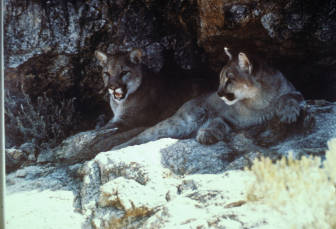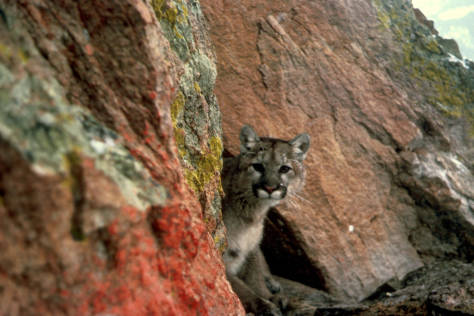
Courtesy USDA
Hi, I’m Holly Strand from Stokes Nature Center in beautiful Logan Canyon.
One cold dawn in January I glanced out the kitchen window at the snow-covered yard. Something moved and my eyes focused on a large dog-sized animal half hidden and crouched behind some rabbit brush. Funny I thought. I’ve never seen a large dog like that in this neighborhood. I continued to watch the backyard visitor but it was very still and hard to see. I raced upstairs to get a better view from the second floor window. As I reached the window I got a brief glimpse of the animal as it melted away into a large ravine. It was definitely not a dog. Dogs don’t “melt” as a method of locomotion.

Given the size, the color, the time of day, and the way it moved, I’m pretty sure that I saw a mountain lion. In winter our yard is a mountain lion pantry, plentifully stocked with live mule deer steaks browsing on our trees. Undoubtedly that’s what attracted my morning visitor.
The mountain lion, or cougar as it is often called, was once the most widely distributed mammal in the Americas. Nowadays, In the United States, it is now mainly restricted to remote areas in the western part of the country including in Utah. According to the Division of Wildlife Resources, the only place in Utah they’re not found is in the salt flats west of the Great Salt Lake.

Courtesy US FWS Digital Library
Although they are found everywhere in the state, the animals are rarely seen. They are extremely secretive and largely nocturnal. They usually know where you are before you know where they are, so they can easily avoid human contact .
Mountain lion attacks are extremely rare and there have been no deaths from them in Utah. Nevertheless, they can kill people and with wildlife-human confrontations on the increase it’s good to know what to do if you meet one of these big kitties. First of all, don’t run from or turn your back to a mountain lion. Its instinct is to chase running animals. Make yourself look as big as possible by raising your arms up high. Speak loudly and fight back if attacked. If you live near mountains or rocky cliff areas keep a close eye on children and pets especially at dusk and dawn.

Courtesy US FWS Digital Library
Thanks to the Rocky Mountain Power Foundation for supporting the development of this Wild About Utah program.
For Wild About Utah and Stokes Nature Center, I’m Holly Strand.
Credits:
Images: Courtesy USDA and US FWS Digital Library
Text: Holly Strand, Stokes Nature Center
Sources & Additional Reading:
Mountain Lion, Wildlife Notebook, Utah Division of Wildlife Resources, https://wildlife.utah.gov/publications/pdf/newlion.pdf
Starving Cougar Attacks Vernal Man, Hans Moran, Deseret News Nov. 12, 1997, https://www.deseretnews.com/article/594408/Starving-cougar-attacks-Vernal-man.html
Mountain Lion, National Geographic, https://animals.nationalgeographic.com/animals/mammals/mountain-lion.html
